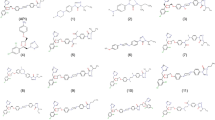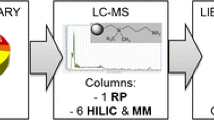Abstract
In drug discovery environment, determination of residual solvents is indispensable and requires rapid analysis covering a maximum number of commonly used solvents especially with small quantity of sample and short run times. As of now, the reported methods require a large amount of sample (~ 50 to 200 mg) and long run times, which is not feasible in the drug discovery environment. Hence, in the present work, we have reported a high-throughput and sensitive GC-FID method by using less amount of sample (5 mg) within 9 min of total run time on DB-624 column with helium as carrier gas. This method is capable of resolving 40 residual solvents and particularly separated nine critical pairs which were not resolved well in earlier reports. As a part of method development, we have evaluated and optimized the relevant chromatographic parameters to improve the separation efficiency and sensitivity. The data acquisition rate of the FID detector was evaluated at different scan rates and significant improvement in the peak response of the analytes was found at 5 Hz by 100-fold. This developed method was validated as per ICH Q2 (R1) and is more advantageous in the drug discovery environment, as it provides high sensitivity and low turnaround time (TAT).




Similar content being viewed by others
Change history
29 June 2022
A Correction to this paper has been published: https://doi.org/10.1007/s10337-022-04186-4
References
ICH guidelines for residual solvents (2016) Q3C(R8). https://database.ich.org/sites/default/files/ICH_Q3C-R8_Guideline_Step4_2021_0422_1.pdf
Residual Solvents. The United States Pharmacopoeia, USP38/NF33 (2012), The United States Pharmacopeial Convention, Rockville, MD, USA. https://www.uspnf.com/sites/default/files/usp_pdf/EN/USPNF/generalChapter467Current.pdf
Camarasu C, Madichie C, Williams R (2006) Recent progress in the determination of volatile impurities in pharmaceuticals. Trends in Anal Chem 25:768–777
Teglia CM, Montemurro M, De Zan MM, Cámara MS (2015) Multiple responses optimization in the development of a headspace gas chromatography method for the determination of residual solvents in pharmaceuticals. J Pharma Analy 5:296–306
Poronsky CJ, Cutrone JQ (2017) Chromatoprobe as a sample-sparing technique for residual solvent analysis of drug discovery candidates by gas chromatography. J Pharma Analy 4:265–269
Panovska AP, Acevska J, Stefkov G, Brezovska K, Petkovska R, Dimitrovska A (2016) Optimization of HS-GC–FID–MS method for residual solvent profiling in active pharmaceutical ingredients using DoE. J Chromatogr Sci 2:103–111
Chen TK, Phillips JG, Durr W (1998) Analysis of residual solvents by fast gas chromatography. J Chromatogr A 1–2:145–150
Nowak T, Graffius GC, Liu Y, Wu N, Bu X, Gong X, Welch CJ, Regalado EL (2016) GC-FID method for high-throughput analysis of residual solvents in pharmaceutical drugs and intermediates. Green Chem 13:3732–3739
Bernardoni F, Halsey HM, Hartman R, Nowak T, Regalado EL (2019) Generic gas chromatography flame ionization detection method using hydrogen as the carrier gas for the analysis of solvents in pharmaceuticals. J Pharm Biomed Analy 165:366–373
Rocheleau MJ, Titley M, Boldue J (2004) Measuring residual solvents in pharmaceutical samples using fast gas chromatography techniques. J Chromatogr B 805:77–86
Klick S, Skold A (2004) Validation of a generic analytical procedure for determination of residual solvents in drug substances. J Pharm Biomed Analy 36:401–409
Tian J, Rustum A (2016) Development and validation of a fast static headspace GC method for determination of residual solvents in permethrin. J Pharm Biomed Analy 128:408–415
Kay J, Thomas R, Gruenhagen J, Venkatramani CJ (2021) Simultaneous quantitation of water and residual solvents inpharmaceuticals by rapid headspace gas chromatography with thermal conductivity detection (GC-TCD). J Pharm Biomed Anal 194:113–796
Urakami K, Saito Y, Fujiwara Y, Watanabe C, Umemoto K, Godo M, Hashimoto K (2000) Determination of residual solvents in bulk pharmaceuticals by thermal desorption/gas chromatography/mass chromatography. Chem Pharm Bull 48:1894–1897
Camarasu C (2002) Unknown residual solvents identification in drug products by headspace solid phase microextraction gas chromatograph-mass spectrometry. Chromatographia 56:S131–S135
Mirmoghaddam M, Kaykhaii M, Yzahyavi H (2015) Recent developments in the determination of residual solvents in pharmaceutical products by microextraction methods. Anal Methods 7:8511–8523
Beitzel F, Gregorevic P, Ryall JG, Plant DR, Sillence MN, Lynch GS (2004) β2-Adrenoceptor agonist fenoterol enhances functional repair of regenerating rat skeletal muscle after injury. J Appl Physiol 96:1385–1392
ICH guidelines (1994) “validation of analytical procedures: text and methodology Q2(R1). https://database.ich.org/sites/default/files/Q2%28R1%29%20Guideline.pdf
Acknowledgements
The authors would like to thank Bristol Myers Squibb and Syngene International Ltd for providing infrastructure support to do this work. Also, the authors thank Dr. Ramaprasad Ganni, Agilent Technologies, Bangalore Urban, Karnataka, India, for providing technical support.
Funding
The authors declare that no funds, grants, or other support were received during the preparation of this manuscript.
Author information
Authors and Affiliations
Contributions
All authors contributed to the study conception and design. Material preparation, data collection and analysis were performed by RAA, and SKC: the first draft of the manuscript was written by RG and MB, and all authors commented on previous versions of the manuscript. All authors read and approved the final manuscript.
Corresponding author
Ethics declarations
Conflicts of Interest
The authors have no relevant financial or non-financial interests to disclose.
Additional information
Publisher's Note
Springer Nature remains neutral with regard to jurisdictional claims in published maps and institutional affiliations.
Supplementary Information
Below is the link to the electronic supplementary material.
Rights and permissions
About this article
Cite this article
Arulraj, R.A., Gajjela, R., Chauthe, S.K. et al. High-Throughput GC-FID Method for the Determination of Residual Solvents in Early-Phase Drug Discovery Samples. Chromatographia 85, 497–506 (2022). https://doi.org/10.1007/s10337-022-04157-9
Received:
Revised:
Accepted:
Published:
Issue Date:
DOI: https://doi.org/10.1007/s10337-022-04157-9




